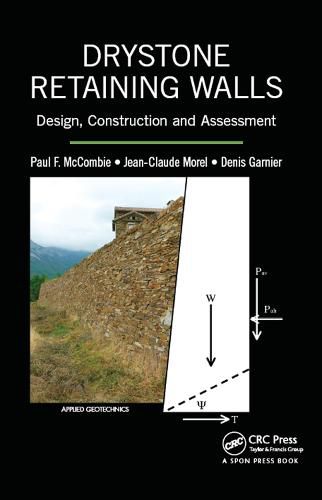Readings Newsletter
Become a Readings Member to make your shopping experience even easier.
Sign in or sign up for free!
You’re not far away from qualifying for FREE standard shipping within Australia
You’ve qualified for FREE standard shipping within Australia
The cart is loading…






Take a Detailed Look at the Practice of Drystone Retaining Wall Construction
Drystone retaining walls make very efficient use of local materials, and sit comfortably in their environment. They make an important contribution to heritage and to the character of the landscape, and are loved by many people who value the skill and ingenuity that has gone into their construction, as well as simply how they look.
And yet, in engineering terms, they are complex. They can deform significantly as their loading changes and their constituent stones weather. This gives them ductility-they deal with changes by adapting to them. In some ways, they behave like conventional concrete retaining walls, but in many ways they are better. They cannot be designed or assessed correctly unless these differences are understood.
Implementing concepts that require no prior knowledge of civil engineering, the authors:
Explain the behavior of earth retaining structures Provide a theoretical framework for modeling the mechanical stability of a drystone retaining wall Outline reliable rules for constructing a drystone retaining wall Include charts to support the preliminary sizing of drystone retaining walls Examine the relevance of drystone in terms of sustainability Describe more advanced methods of analysis
Drystone Retaining Walls: Design, Construction and Assessment draws on theoretical work and full-scale practical testing to explain how these structures work, without presuming that the reader has received an engineering education. The book goes on to give enough detail to give the professional engineer confidence in the methods used in design and assessment, and insight into what matters most in the way in which drystone retaining walls are built. It shows how to design new or replacement drystone retaining walls that are efficient, sustainable, attractive, and in keeping with the character of the area where they are built, and demonstrates how to make fair assessments of existing walls.
$9.00 standard shipping within Australia
FREE standard shipping within Australia for orders over $100.00
Express & International shipping calculated at checkout
Take a Detailed Look at the Practice of Drystone Retaining Wall Construction
Drystone retaining walls make very efficient use of local materials, and sit comfortably in their environment. They make an important contribution to heritage and to the character of the landscape, and are loved by many people who value the skill and ingenuity that has gone into their construction, as well as simply how they look.
And yet, in engineering terms, they are complex. They can deform significantly as their loading changes and their constituent stones weather. This gives them ductility-they deal with changes by adapting to them. In some ways, they behave like conventional concrete retaining walls, but in many ways they are better. They cannot be designed or assessed correctly unless these differences are understood.
Implementing concepts that require no prior knowledge of civil engineering, the authors:
Explain the behavior of earth retaining structures Provide a theoretical framework for modeling the mechanical stability of a drystone retaining wall Outline reliable rules for constructing a drystone retaining wall Include charts to support the preliminary sizing of drystone retaining walls Examine the relevance of drystone in terms of sustainability Describe more advanced methods of analysis
Drystone Retaining Walls: Design, Construction and Assessment draws on theoretical work and full-scale practical testing to explain how these structures work, without presuming that the reader has received an engineering education. The book goes on to give enough detail to give the professional engineer confidence in the methods used in design and assessment, and insight into what matters most in the way in which drystone retaining walls are built. It shows how to design new or replacement drystone retaining walls that are efficient, sustainable, attractive, and in keeping with the character of the area where they are built, and demonstrates how to make fair assessments of existing walls.